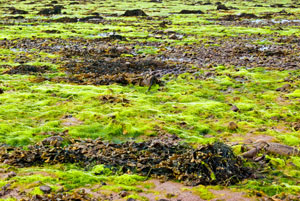
Forms of lower-Life/Organisms in drinking water, part I
ALGAE
These organisms are found throughout the world. Simple algaes exist in the Monera and Protista kingdoms. Other algae are plants. They constitute single-celled or simple multicellular photosynthetic organisms that are important producers-produce their own food by using energy from sunlight to synthesize complex molecules from carbon dioxide and water-both in sea and freshwater. Algae range in size from microscopic organisms to giant seaweeds several hundred feet in length. They contain chlorophyll and other pigments which give them a variety of colors. They manufacture their food by photosynthesis.

Algae thrive well in stagnant surface waters, especially during warm weather. Algae give water fishy, grassy, earthy, musty, and other even more objectionable odors. While algae-laden waters are repulsive to man, animals will drink them, and the presence of blue-green algae has been known to cause the death of cattle drinking this water.
DIATOMS
Diatoms are algal protists belonging to the plant-like (algae) portion of the Protista kingdom. Some exist as single cells, others are found as groups or colonies. More than 15,000 forms of diatoms are known to exist. Diatoms have silica-impregnated cell walls. At times, they release essential oils which give water a fishy taste.
FUNGI
Fungi have many varieties. Included among these are molds, mildews, mushrooms, yeast, rust, and smut. Fungi are not able to manufacture their own food; they contain no chlorophyll. They exist by feeding on living things or on dead organic matter. Like bacteria, fungi are important decomposers that break down the wastes and the bodies of dead organisms making their components available for reuse. Depending on their individual characteristics, they are usually colorless but may vary in this respect.
MOLDS
One important category of fungi is molds. This group of fungi feeds entirely on organic matter. They decompose carbohydrates, such as sugars, starches, and fats, as well as proteins and other substances. They thrive ideally in water that has a temperature range of approximately 80° to 100°F. The presence of molds is generally a strong indicator of heavy pollution of water.





